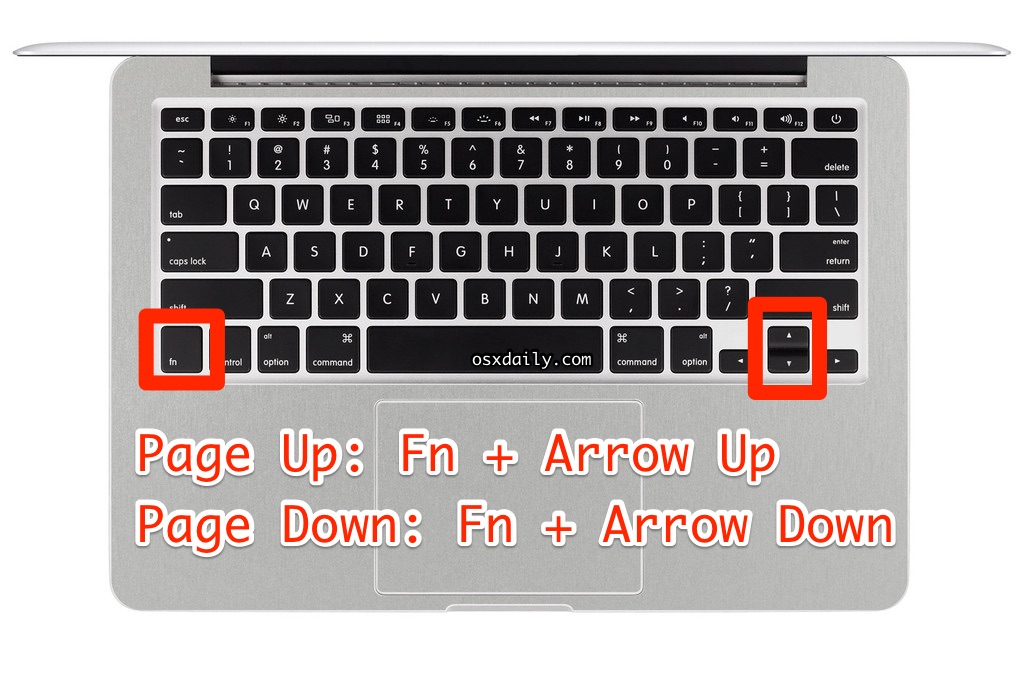Page Down with Fn + Down Arrow Paging down is done the same way as paging up, using the same 'fn' key and the Down arrow to perform the equivalent of a page down on a Mac keyboard. Yes, this is the same on all Mac keyboards, including the Apple Wireless Keyboard, the MacBook Pro keyboard, MacBook Air, and MacBook keyboards. On a Mac, when you hit the page up or page down keys, (fn + down arrow or fn + up arrow), it will only move the screen, not the cursor. If you would like to move the cursor and the screen both then you will need to use the Option Keys + Page Up or Page Down or (Option Key + Fn + Up Arrow/Down Arrow). On a Mac it has always been tap the space bar for page down or Command up or down arrow to got the the top or bottom of the page. Use the free and excellent BetterTouchTool to program a shortcut for those keystrokes on your trackpad or Magic Mouse, in my case a single finger tap in the top middle of the trackpad takes me to the the top, the same tap applied to the middle bottom of the trackpad.
Updated for Mac OS X Mountain Lion 10.8.2.
- If the active cell is empty, Excel will extend the selection to the first non-empty cell below the active cell. If the active cell is non-empty, Excel will extend the selection on the last non-empty cell below the active cell. On a Mac, the command key (⌘) can be used instead of the control key.
- In case you are using a Windows keyboard on your Mac Mini, you can easily go Page up or Page down by using the Page up and Page Down keys on your Windows keyboard. You can also use the Windows + Up Arrow key combination to go Page Up and Windows + Down Arrow Key combination to go Page Down. How to Enable Picture-In-Picture Mode On Mac.
How To Page Down On Macbook Air
In order to get page up and page down to work properly under Mac OSX Terminal, as well as the home and end of line (EoL), you need to go to Preferences and then Keyboard and configure the right escape key sequences.
(Note for laptop users: you don't have the page up/down and home/EoL keys, but you can simulate them by holding the 'fn' key and pressing on an arrow key. So these configurations also apply to you.)
In the Terminal Preferences, go to the Keyboard pane and watch the the keys named 'page up', 'page down', 'home' and 'end'. You will see they already exist but are configured to scroll the buffer rather than sending commands to the server you're connected to.
In order to change this, double click on each of the relevant lines and select Action: 'Send string to shell:'
How To Page Down On Mac Laptop
You then need to enter the correct string to send to the shell. This is a multiple key sequence starting with the escape character (which is represented with it's octal code 033). Here are strings you can use for each key:
As of OSX 10.6.8, the correct fix is:
| Key | Recommended Escape Sequence | Other possible sequences you can try if the recommended doesn't work for you | ||
|---|---|---|---|---|
| Home | 033OH | 033[1~ | 033[H | 001 |
| End | 033OF | 033[4~ | 033[F | 005 |
| Page Up | 033[5~ | |||
| Page Down | 033[6~ |
How To Page Down On Mac Book Pro
You can either type these strings on your keyboard (start by presseing Esc) or you can just copy paste the strings from above.

It is worth noting that some of these are already bound to Shift-Page Up, Shift-Page Down, Shift-Home and Shift-End (which are obtained with Shift-Fn-Up/Down/Left/Right on a laptop keyboard). So if you can change your habits slightly you don't actually need to reconfigure anything.
Also note that some people (including Apple) recommend to use 033[H for Home but this doesn't actually work in vi or vim. This is why I recommend using 033OH which has worked in any shell or editor for me so far (Mac terminal, Debian terminal, vim, etc.)
If the recommended sequences don't work for you: please try the alternative suggested here. Also please let us know with which shell or editor you are trying to make them work and which escape sequences work best for you. This way we can order them in order of popularity and possibly give specific advice for specific environments to future visitors of this page. Thank you for your feedback.

